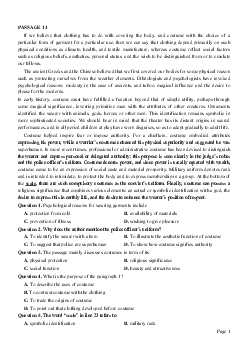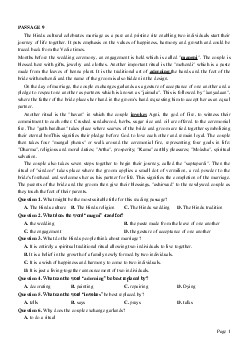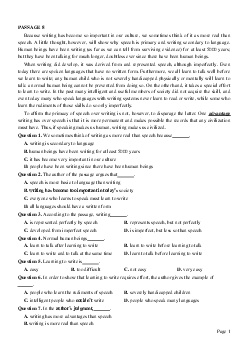



Preview text:
PASSAGE 10
Alzheimer’s disease impairs a person’s ability to recall memories, both distant and as a few hours before.
Although there is no yet a cure for the illness, there may be hope for a cure with a protein called nerve
growth factor. The protein is produced by nerve cells in the same region of the brain where Alzheimer’s
occurs. Based on this relationship, scientists from the University of Lund in Sweden and the University of
California at San Diego designed an experiment to test whether doses of nerve growth factor could
reverse the effects of memories loss caused by Alzheimer’s. Using a group of rats with impaired memory,
the scientists gave half of the rats doses of nerve growth factor while giving the other half a blood protein
as a placebo, thus creating a control group. At the end of the four-week test, the rats given the nerve
growth factor performed equally to rats with normal memory abilities. While the experiment do not show
that nerve growth factor can stop the general process of deterioration caused by Alzheimer’s, they do
show potential as a means to slowing the process significantly.
Question 1. With what topic is this passage mainly concerned?
A. impaired memory of patients
B. cures for Alzheimer's disease
C. the use of rats as experimental subjects
D. nerve growth factor as a cure for Alzheimer's
Question 2. The word "impairs" in line 1 is most similar to which of the following? A. affects B. destroys C. enhances D. diminishes
Question 3. According to the passage, where is nerve growth factor produced in the body?
A. in nerve cells in the spinal column
B. in red blood cells in the circulatory system
C. in nerve cells in the brain
D. in the pituitary gland
Question 4. Which of the following is closest in meaning to the word "region" as used in line 3? A. vicinity B. plain C. expanse D. orbit
Question 5. Which of the following is closest in meaning to the word "doses"? A. measures B. pieces C. injections D. stipends
Question 6. Which of the following can be inferred from the passage?
A. Alzheimer's disease is deadly.
B. Though unsuccessful, the experiments did show some benefits derived from nerve growth factor.
C. The experiments did not show any significant benefits from nerve growth factor.
D. More work needs to be done to understand the effects of nerve growth factor.
Question 7. The passage most closely resembles which of the following patterns of organization? A. chronological order
B. statement and illustration C. cause - effect D. alphabetical order
Question 8. Which of the following is closest in meaning to the word "deterioration"? A. depression B. deduction C. decline D. disconnection
Question 9. Which of the following could best replace the word "significantly"? A. considerably B. knowingly C. suggestively D. tirelessly
Question 10. The relationship between nerve growth factor and a protein is similar to the relationship between Alzheimer's and A. forgetfulness B. a disease C. a cure D. a cancer Page 1 ĐÁP ÁN 1-D 2-D 3-C 4-A 5-A 6-D 7-B 8-C 9-A 10-B
LỜI GIẢI CHI TIẾT Question 1:
Giải thích: Chủ đề chính của bài văn là gì?
A. trí nhớ suy giảm của bệnh nhân
B. sử dụng chuột làm vật thí nghiệm
C. những phương pháp chữa trị bệnh Alzheimer’s
D. sử dụng chất phát triển thần kinh làm thuốc trị bệnh Alzheimer’s
“… whether doses of nerve growth factor could reverse the effects of memory loss caused by
Alzheimer's” (liệu những phương thức của các yếu tố tăng trưởng thần kinh có chống lại tác động suy
giảm trí nhớ của Alzheimer). Các câu khác trong bài làm sáng tỏ cho ý chính này. Question 2:
Giải thích: Từ “impair” ở dòng 1 gần nghĩa nhất với từ nào sau đây?
(to) impair = (to) diminish: làm suy yếu, suy giảm Các đáp án còn lại:
(to) affect: ảnh hưởng, tác động (to) destroy: phá hủy
(to) enhance: tăng cường, nâng cao Question 3:
Giải thích: Theo bài văn, chất phát triển thần kinh được sinh ra ở đâu?
A. ở những tế bào thần kinh trong cột sống
B. ở những tế bào máu trong hệ tuần hoàn
C. ở những tế bào thần kinh trong não D. ở tuyến yên
“…a protein called nerve growth factor. The protein is produced by nerve cells in the same region of the
brain” (…một loại protein được gọi là yếu tố phát triểnthần kinh. Loại protein này được sản xuất bởi tế bào thần kinh ở não.) Question 4:
Giải thích: Từ nào sau đây gần nghĩa nhất với từ “region” ở dòng 3?
vicinity (n) = region (n): vùng Các đáp án còn lại: plain (n): đồng bằng
expanse (n): = a large, open area of land, sky or sea: khu vực rộng lớn (đất liền, bầu trời hay biển) orbit (n): quỹ đạo Question 5: Page 2
Giải thích: Từ nào sau đây gần nghĩa nhất với từ “doses”?
dose (n) = measure (n): a measured amount of something, especially medicine: lượng, liều Các đáp án còn lại: piece (n): mẩu, mảnh
injection (n): liều tiêm chủng stipend (n): lương Question 6:
Giải thích: Từ bài văn có thể suy ra câu nào trong các câu sau đây?
A. Bệnh Alzheimer gây chết người
B. Dù không thành công nhưng những cuộc thí nghiệm đã thể hiện một số lợi ích của chất phát triển thần kinh.
C. Những cuộc thí nghiệm đã không chỉ ra bất cứ lợi ích đáng kể nào của chất phát triển thần kinh.
D. Cần nhiều nỗ lực hơn để hiểu về những ảnh hưởng của chất phát triển thần kinh.
Dẫn chứng: “At the end of the four-week test, … While the experiments do not show that nerve growth
factor can stop the general process of deterioration caused by Alzheimer's, they do show potential as a
means to slowing the process significantly.” (4 tuần tiến hành điều tra… Mặc dù thí nghiệm không chứng
minh được loại protein này có thể ngăn chặn quá trình suy giảm do Alzhemer gây ra, chúng chỉ ra một
phương thức tốt để làm chậm quá trình này.) => Như vậy những cuộc thí nghiệm chưa đạt được mục đích
ban đầu là kiểm tra xem whether doses of nerve growth factor could reverse the effects of memory loss
caused by Alzheimer's” (liệu những phương thức của các yếu tố tăng trưởng thần kinh có chống lại tác
động suy giảm trí nhớ của Alzheimer) Question 7:
Giải thích: Tác giả đã sắp xếp bài văn theo hình thức nào sau đây? A. trật tự thời gian
B. khẳng định và minh họa
C. nguyên nhân – kết quả
D. trật tự theo bảng chữ cái
Đầu tiên, tác giả đưa ra chủ đề về vai trò của chất phát triển thần kinh trong việc chữa bệnh Alzheimer’s: .
“Although there is not yet a cure for the illness, there may be hope for a cure with a protein called nerve
growth factor.” , sau đó đưa ra các ví dụ minh hoạ từ những cuộc thí nghiệm của các nhà khoa học. Question 8:
Giải thích: Từ nào sau đây gần nghĩa nhất với từ “doses”?
deterioration (n) = decline (n): sự suy giảm Các đáp án còn lại:
depression: (n) sự trầm cảm, suy sụp
deduction: (n) sự kết luận
disconnection: (n) sự cắt rời, sự tháo rời/sự ngắt kết nối Question 9:
Giải thích: Từ nào sau đây có thể thay thế từ “significantly”? Page 3
considerablely (adv) = significantly (adv): đáng kể Các đáp án còn lại:
knowingly (adv): chủ tâm, cố ý, có dụng ý
suggestively (adv): có tính gợi ý, khơi gợi
tirelessly(adv): một cách không mệt mỏi Question 10:
Giải thích: Mối quan hệ giữa chất phát triển thần kinh và protein giống với mối quan hệ giữa Alzheimer’s và A. sự đãng trí B. một căn bệnh C. sự cứu chữa D. bệnh ung thư
Chất phát triển thần kinh là một loại protein => Alzhemei’s là một căn bệnh => Chọn B BÀI DỊCH
Bệnh Alzheimer’s huỷ hoại khả năng gợi lại những ký ức của con người, kể cả là từ lâu hay gần như mới
vài tiếng trước. Mặc dù chưa có phương pháp cứu chữa nhưng vẫn có hy vọng để chữa trị với 1 loại
protein gọi là chất phát triển thần kinh. Loại protein này được sinh ra bởi những tế bào thần kinh nằm
trong cùng một vùng của não, nơi mà bệnh Alzheimer’s diễn ra. Dựa vào mối quan hệ này, các nhà khoa
học đến từ trường đại học Lund, Thuỵ Điển và trường đại học California ở San Diego đã thiết kế một
cuộc thí nghiệm để kiểm tra xem liều lượng của chất phát triển thần kinh có thể đảo ngược lại những ký
ức đã mất vì bệnh Alzheimer’s không. Sử dụng một nhóm chuột với trí nhớ bị suy giảm, các nhà khoa
học đã cho 1 nửa số chuột uống liều phát triển thần kinh trong khi cho nửa còn lại uống một loại protein
trong máu như là liều thuốc an thần, do vậy có thê kiểm soát được cả nhóm. Sau 4 tuần kiểm thử nghiệm,
những con chuột được uống thuốc phát triển thần kinh đã bình phục như những con chuột có trí nhớ bình
thường. Trong khi cuộc thí nghiệm không chỉ ra rằng chất phát triển thần kinh có thể ngăn quá trình hư
tổn bị gây ra bởi Alzheimer’s, chúng đã đưa ra một phương án tiềm năng để làm chậm quá trình một cách đáng kể. Page 4




